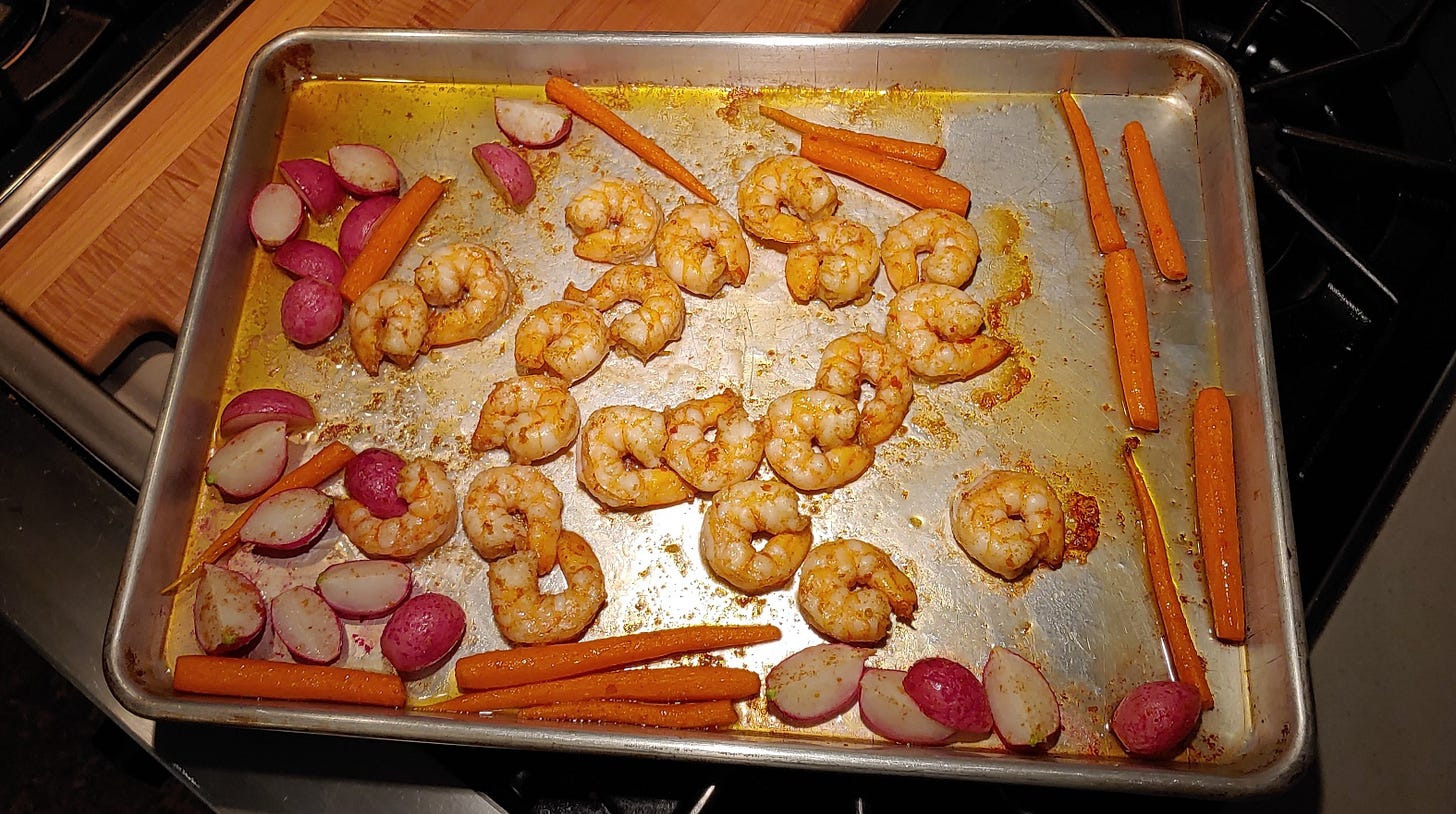No. 6: Frozen and Tinned Seafood
Options for convenience, with a side trip to Lisbon and a quick shrimp recipe
Maybe I should start a running list of seafood attributes, to capture in one place the various benefits and delights of seafood that come up in this newsletters over time. And perhaps keep track of which attributes get more frequent mention than others. One thing I’d add to that list today is convenience.
In this case, convenience in the form of storable versions of seafood—frozen and canned—that allow you to use the seafood on your own schedule, not within the limited window of fresh product that’s best cooked sooner than later. Sometimes convenience can come at some degree of a cost, such as flavor or texture that’s not on par with the less-convenient version, but still satisfying and good enough at the moment. Instant mashed potatoes randomly just came to mind. I can picture that box in our kitchen, Mom pulling it out now and then for a last-minute side dish with dinner. Nostalgia aside, I wouldn’t soon choose instant over a steaming bowl of freshly-mashed potatoes.
When it comes to seafood, many of the convenient options are also quite high-quality options. Seafood in the freezer section has been frozen very shortly after harvest, sometimes within hours. As long as it stays solidly frozen between then and when you get it, the quality should be very good. It’s your job to ensure it remains fully frozen until you thaw before cooking; it’s not a good idea to refreeze thawed seafood.
And for no-fuss appetizers when friends are over, or a personal evening aperitif, having outstanding tinned seafood on hand to serve is a joy. Tinned seafoods also dress up meals with extra flavor, nutrition, and panache, not to mention traveling well for snacks-on-the-go. Here’s to convenience in the delicious form of seafood.

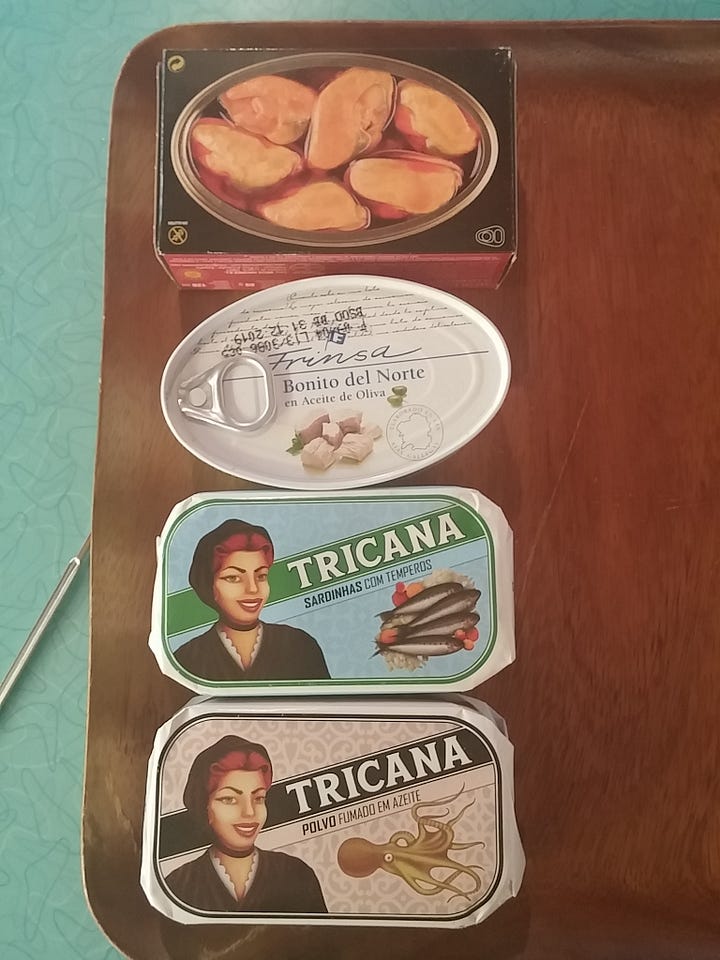
At the Market: Going for Frozen
Among the things I’ve valued most about responses to my seafood shopping survey (hop on over to add your input if you haven’t filled it out yet, thanks to those who have!) are the perspectives folks have shared in the comments. Many mention specific seafood they buy frozen, LOTS of references to frozen shrimp (you may have some in your freezer right now too), along with various fish fillets, lobster tails, and other items. Some also talk about preferring frozen, at least at times, so they can prolong how soon they cook the seafood and have more control over the time between thawing and cooking.
Those respondents, and many other seafood fans, have a soft spot in their kitchen for frozen seafood. But I fear that frozen seafood still has a bit of an image problem. Or it can at times, particularly with folks who may have experienced poorly-frozen seafood in the past, or those who simply assume frozen is universally inferior to fresh. I have thoughts on what “fresh seafood” really means (or doesn’t) but saving that for further discussion later. Instead today it’s about the benefits and value that frozen seafoods offer.
A simple starting point is convenience. When you buy frozen seafood, you’ve got months to store it* and pull out to thaw and cook when needed. So not only do you get great leeway with timing relative to using it, you also have provisions on hand when dinner slips your mind and you don’t have the time/energy to run to the store. Another plus is that with most frozen seafood it’s easy to thaw just what’s needed, as in for dinner-for-two: part of a bag of frozen shrimp, a couple portions of individual fillets. The rest stays tucked in its corner of the freezer until needed.
Shrimp, scallops, crab portions, fillet pieces—they thaw pretty quickly, so even a relatively last-minute decision to cook from the frozen stash can work out well. (I know some swear by the option of cooking fish directly from its frozen state; I haven’t experimented much with that, will do so and share more later.) I officially recommend following the suggestions on the package relative to thawing. And I’ve frequently written about ‘thawing slowly overnight in the refrigerator’ as being optimal to maintain best quality of the seafood, which it is. But in a pinch, you can put frozen seafood (in its well-sealed packaging or sealed inside a zip-top plastic bag) into a bowl of cold water, changing the water ever 30 minutes, just until the seafood is thawed. Then you’re good to go with whatever delicious preparation is on the menu for the evening.
* There’s an important distinction here, purchasing commercially-frozen seafood vs seafood you might freeze yourself at home. Home freezers aren’t nearly as cold as commercial freezers are. And with commercial freezers folks aren’t opening the doors with relative frequency to get ice cubes, ice cream or other treats within, thus messing with the freezer’s efforts to hold its cold temps (at least I assume that to be true). In our home freezers, the seafood freezes more slowly than in a commercial setting, which can impact the quality of the flesh a bit and it doesn’t hold up as well for a long haul. When I got an abundance of trout fillets over the summer and surely wasn’t going to go through them quickly, I pulled out some zip-top bags and did my best to seal them with minimal air inside (yeah, maybe it’s time I get a vacuum sealer….) before putting them in the freezer we have in the basement. The fillets held up well for a couple months, longer would not have done them any favors. With vacuum-sealed packages and an extra-cold, seldom-opened freezer, I can see home-frozen seafood holding up for a handful of months. But I’d still recommend only commercially-frozen seafood for longer storage.
In the Kitchen: Tinned Seafoods
I’m pretty sure there was always a can or two of seafood on the shelf when I was a kid. For snacking, there were sardines and smoked oysters. It took me years to become a fan of the former, but I’ve liked those basic smoked oysters from the grocery store for as long as I can remember. Mom would make salmon cakes with canned salmon, which I recall liking—it’s been ages since I’ve bought canned salmon, time to revisit that pantry staple and recreate mom’s salmon cakes.
Over the years my horizons of tinned seafood have expanded a lot, veritably exploding on my first trip to Portugal eight years ago (more on that below). And in recent years the shelf space allocated to tinned seafood has been expanding, which I’ve noticed especially at specialty food stores like DeLaurenti in Seattle and Providore in Portland, Oregon.
I’ve been reading and hearing about Scout tinned seafoods lately (based in PEI, I believe, with a particular focus on responsibly-sourced seafood from North America) and picked up their trout with dill at my neighborhood grocery earlier this year. While writing this issue, it seemed an ideal time to give it a try. I took a prompt from the box’s recommendation to grab some seasonal greens (check! I had some pretty pink radicchio and green cabbage in the fridge) and to use the herbed oil in the tin for a vinaigrette, to which I added red wine vinegar and a touch of olive oil. Perched atop the dressed slivered cabbage and radicchio, the trout was delicious (if a bit hidden against the colors of the salad), a vibrant and flavorful embellishment.
There’s a lot to love about tinned seafoods. Just pop the lid and dive in, with crackers alongside. Add some olives, cheese, and sliced bread—you’ve got a stellar spread for happy hour. Take cans on a picnic or hike. Embellish pasta or pizza or whatever salad is on the menu. So many options.
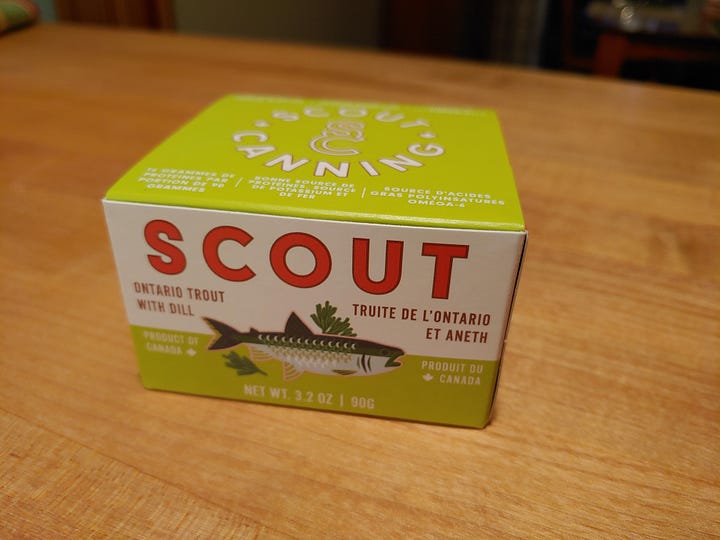

On the Road: Portugal
Or, Lisbon to be specific, in this instance. It dates back a few years, our trip to Portugal, which included a cruise along the Douro River and a few days across the border in Santiago de Compostela. In the time since, whenever asked about tips for others going to Lisbon, a few things come to mind. For one, the really interesting Estufa Fria gardens in an expansive greenhouse within the Eduardo VII Park. Another is definitely having a meal at Cervejaria Ramiro for exquisite seafood. We dined on shrimp small, medium, and gigantic, as well as gooseneck barnacles. With incredible Iberian ham served after, for dessert!
But I digress. I’m here to talk about the tinned seafoods to be found around town (and around Portugal, but this is where we did most of our strolling and shopping). Hands-down imperative for the agenda when in Lisbon is a visit to the Conserveira de Lisboa, I’d say. Not only is it a cozy, seemingly timeless small store that exudes charm, it has a pretty mind-blowing array of selections that make standard sardines and smoked oysters seem utterly mundane.
Certainly other stores in town sell tinned seafoods. This spot great for its location a few minutes’ walk from the historic square near the waterfront with its gorgeous sculpted archway and ornate statue, where most visitors end up at some point. An easy stop while exploring Lisbon.
I don’t recall how many tins I bought, they’re hidden under that brown-paper-and-string wrap in the photo below. It was enough to parse out over many months, to share for special occasions and use as gifts. The striking design of the individually-wrapped tins, array of interesting seafood and seasoning combos available, compact size and bonus of being unbreakable—pretty much one of the best, and most delicious, souvenirs I’ve come across in recent years. Until I can make it back to Portugal to stock up on more, I can thankfully content myself with the array of great options available closer to home.


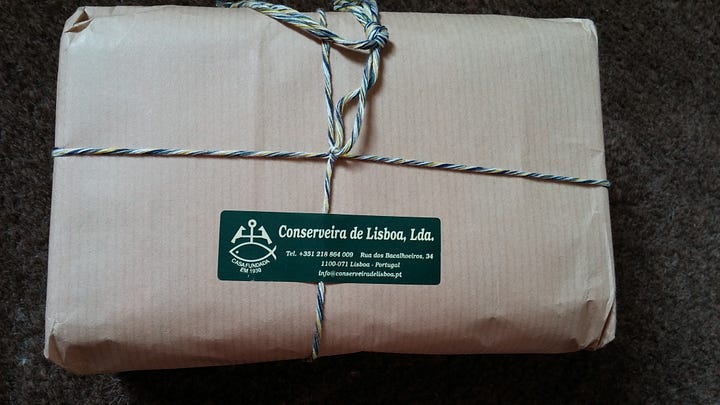
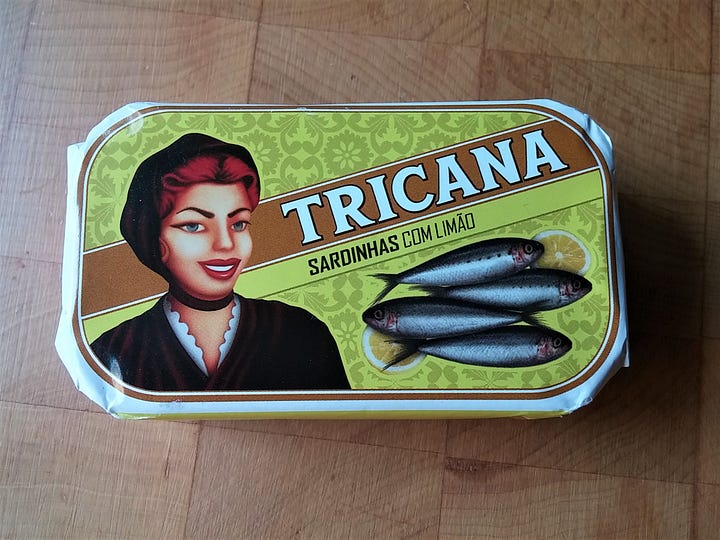
Recipe Box: Harissa-Roasted Shrimp, Carrots, and Radishes
Sharing a recipe with you from my latest book, Shellfish, one that’ll be a quick, easy option for using some of those shrimp you likely have tucked in the freezer. I’ve been getting a generous supply of delicious carrots in the last few deliveries of my weekly CSA (Community Supported Agriculture, for my subscription I get a big bag of produce and eggs delivered from local farmers). I most always have harissa in the fridge, and cumin and coriander are two favorite spices in regular supply. I’d just need to pop to the store for some radishes to make this today, or go with a carrot-only version, just as delicious. Not sure if you have the same provisions handy, feel free to amend based on your preferred seasonings and vegetables. I’m sure zucchini, mushrooms, turnips would work well. Keep even cooking in mind, cutting larger/denser vegetables in small enough pieces so all will cook in the same time.
I’d only been familiar with the paste version of harissa for many years, which comes in varying styles (generally based on chiles, garlic, and olive oil with a range of potential other seasonings) and heat levels. More recently I learned of the dried version, here’s an example from my favorite spice shop in Seattle, World Spice. Either form will work here, though a bit extra olive oil may be needed if using the dried, for ideal coating consistency of the spice blend.
12 ounces small to medium carrots, trimmed
2 bunches radishes, trimmed
1/4 cup mild olive oil, plus more if needed
1 to 2 tablespoons harissa
3/4 teaspoon ground cumin
1/2 teaspoon ground coriander
1/2 teaspoon kosher salt
1 1/2 pounds medium to large shrimp, peeled, deveined, and rinsed
Preheat the oven to 450 degrees F.
Cut larger carrots across into 3- to 4-inch lengths, and then cut in half or quarters lengthwise so they’re not much more than 1/2 inch wide; extra-small carrots can be used as is. Small radishes can be cooked as is; medium or large radishes should be halved or quartered.
Combine the oil, harissa, cumin, coriander, and salt in a large bowl and use a rubber spatula to evenly mix the seasonings. Add the shrimp, carrots, and radishes and toss to evenly coat. If using dried harissa and the coating is a bit sparse, add another 1 or 2 tablespoons oil and toss again.
Transfer the shrimp and vegetables to a rimmed baking sheet, spreading them out in an even layer with the shrimp toward the center and the vegetables around the edge. Use the spatula to get all the flavorful oil from the bowl onto the shrimp and vegetables. Roast until the carrots and radishes are just tender and the shrimp are opaque through the thickest part, 10 to 12 minutes.
Transfer the shrimp and vegetables to individual plates and serve right away.
Makes 4 servings





